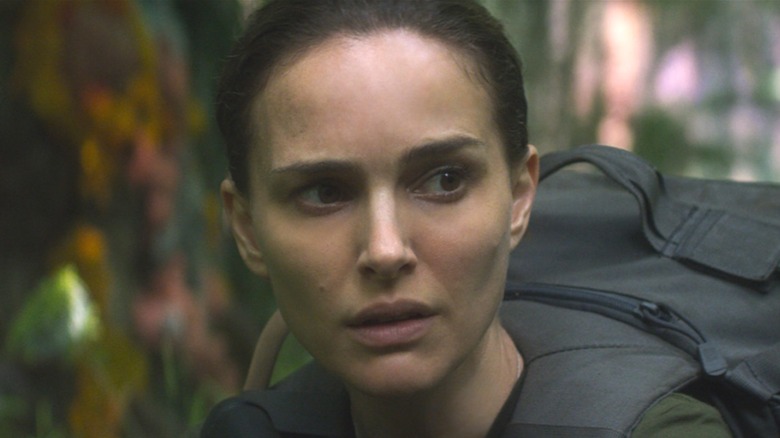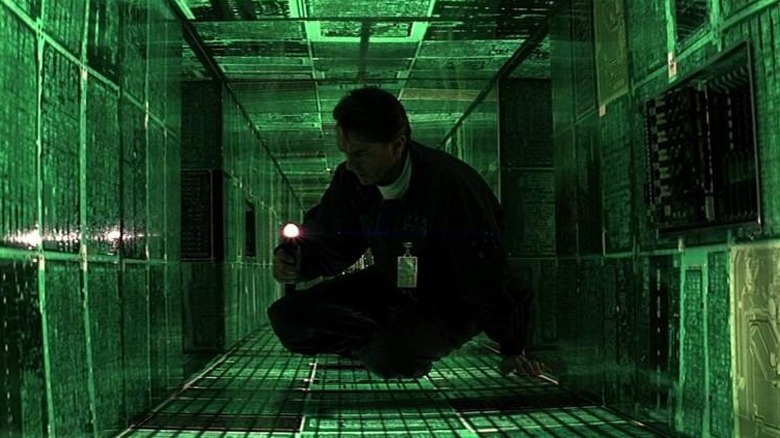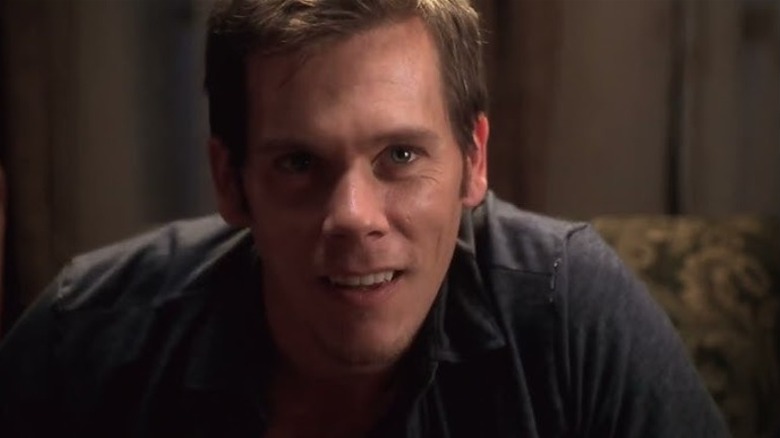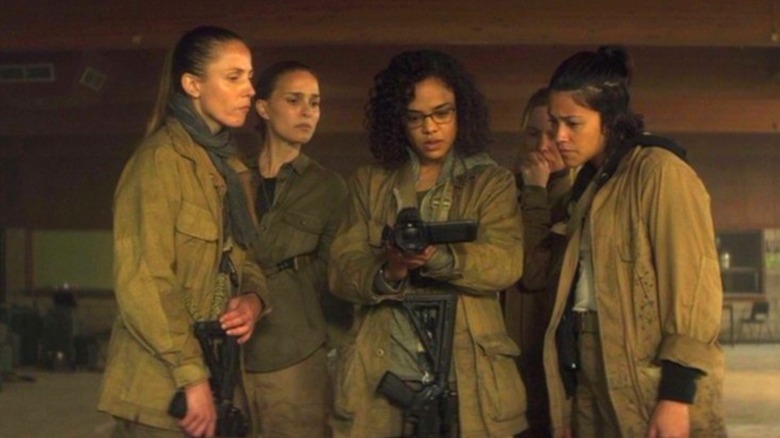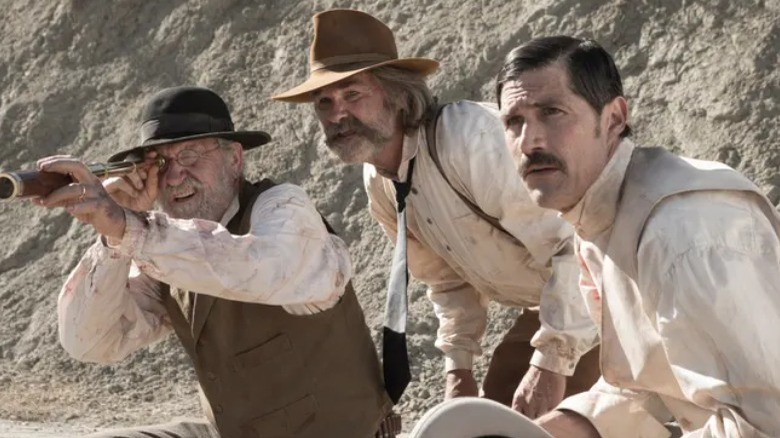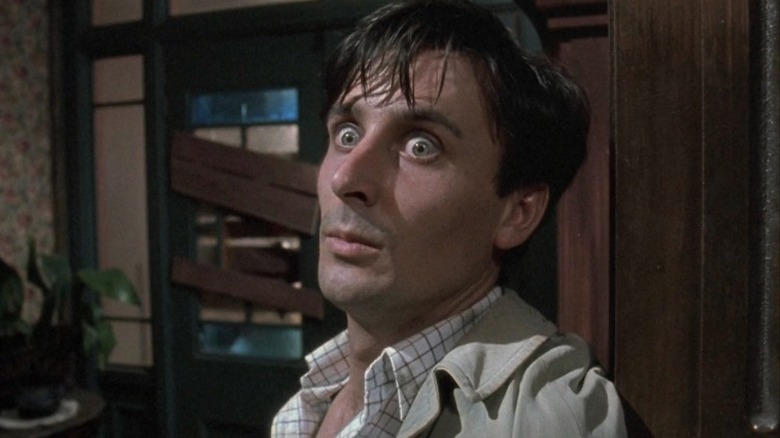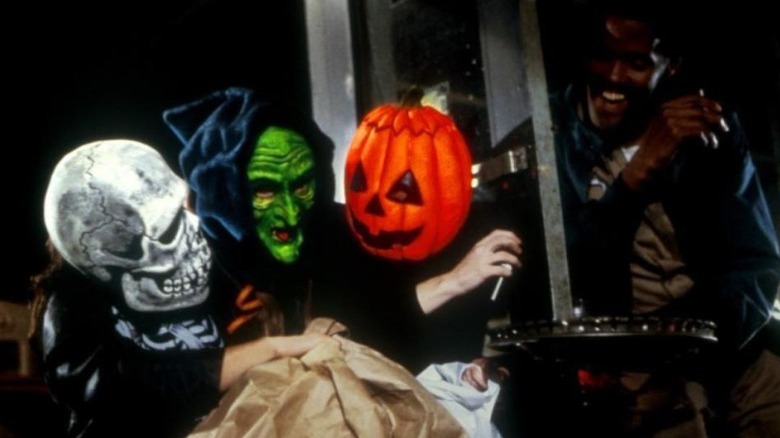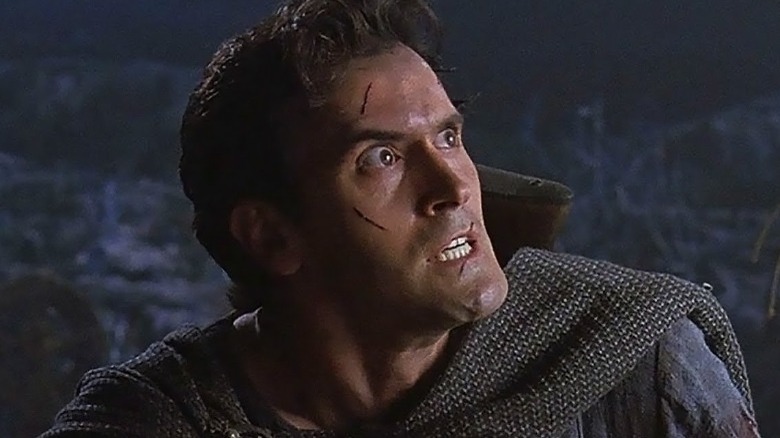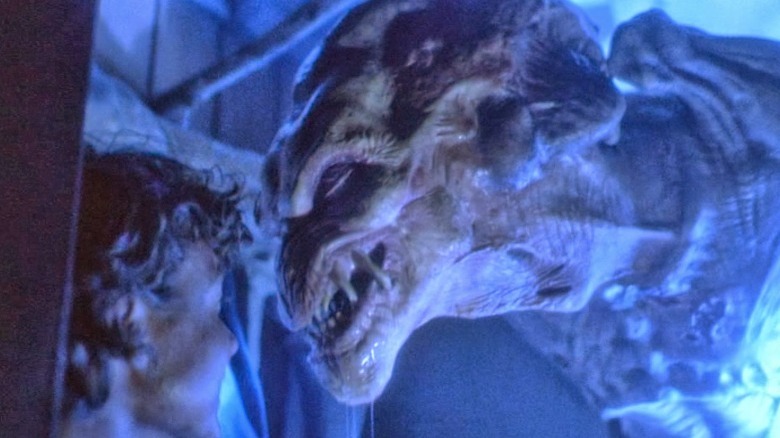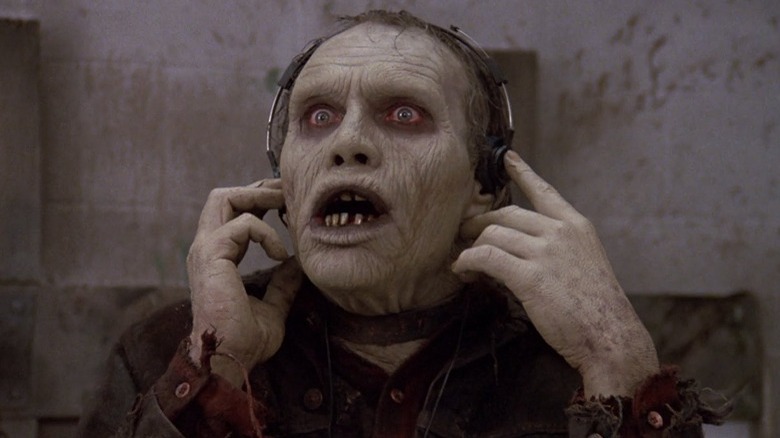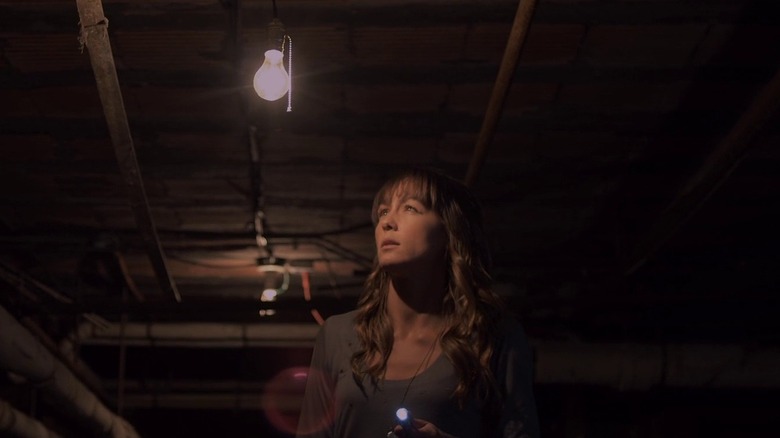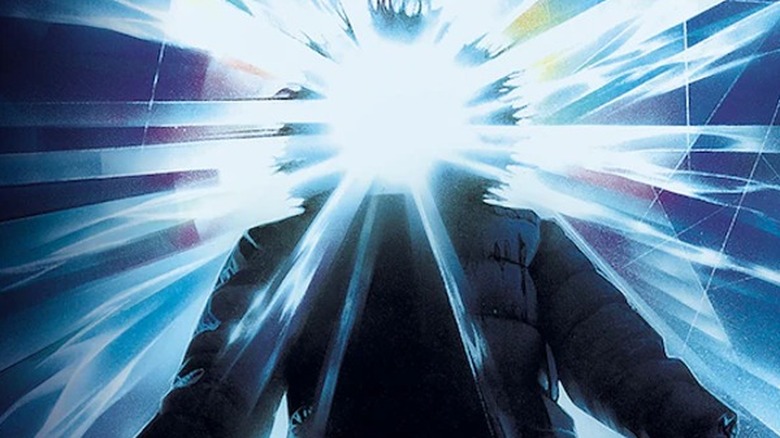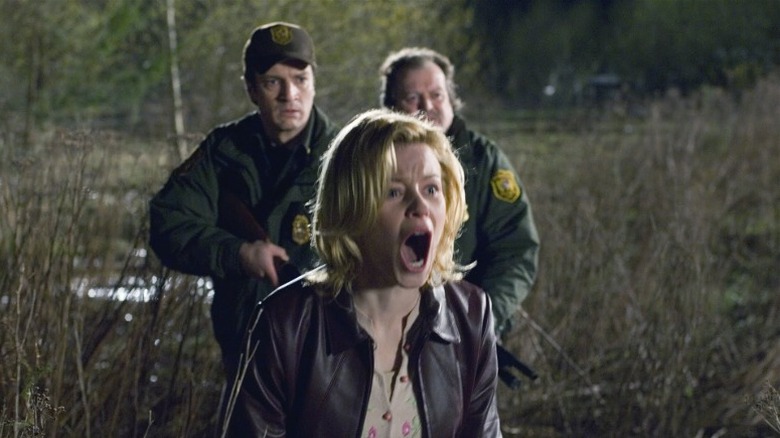12 Horror Films That Bombed At The Box Office But Still Became Cult Classics
"If I was an imitation, a perfect imitation, how would you know if it was really me?" Childs (Keith David) asks MacReady (Kurt Russell) in John Carpenter's "The Thing," a film about a horrific assimilating alien creature that stops at nothing to consume all living organisms in its path. Most horror fans are familiar with "The Thing" and its unmitigated atmosphere of anxiety. It's a technical marvel rife with some of the best practical effects ever in horror and many consider it to be one of the best horror films around.
But it wasn't originally the beloved masterpiece that it's revered as today. In fact, "The Thing" was a box office bomb upon its 1982 release. Not only did the audience hardly show up for this pulse-pounding thrill ride, but critics like Roger Ebert lambasted the film as a gratuitous gore-fest with one-dimensional characters.
If this all seems a bit heretical to you, just know that "The Thing" joins a long line of horror films that have transformed from box office busts to enduring cult classics. Your parents may have taught you that first impressions are everything. But that's not always the case when it comes to cinema. Tolerances and palates often change, and sometimes a film simply needs to marinate and later be re-examined for the multi-faceted and smart filmmaking that it is.
These are the horror films that weren't afforded the proper respect they deserved at the time of release but eventually gained favor in the sight of fandom and pop culture at large.
Event Horizon
The Sam Neill and Laurence Fishburne-led horror "Event Horizon" is nothing short of an unforgettable descent into hellish madness. The film follows the crew of a starship in the year 2047, which is tasked with answering the distress signal of another space-faring vessel called the Event Horizon. This mysterious ship had suddenly disappeared seven years prior during its maiden voyage and has now eerily reappeared in orbit around Neptune.
What the crew finds on the Event Horizon is the stuff of nightmares. The crew has been massacred, and the ship's visual records depict the crew members losing their minds and engaging in sexual activity and body mutilation. The rescue crew then begins seeing horrific hallucinations that recall their own individual histories. The mysteries of the Event Horizon all revolve around its strange disappearance. Experimental space travel effectively took the ship to another dimension: Hell.
Director Paul W.S. Anderson was riding high after the success of the 1995 movie adaptation of the popular video game "Mortal Kombat" but shifting from PG-13 material to a hard-R horror proved to be financially detrimental for the director. Upon its 1997 release, "Event Horizon" only grossed nearly $42 million worldwide against a $60 million budget (via The Numbers).
Critically, it was panned for its "gratuitous gore" according to the Rotten Tomatoes Critics Consensus. However, horror fans began flocking to the film in droves as years passed, causing multiple home editions to be released and spurring on another examination of the film's critical standing.
Stir of Echoes
Do you remember "The Sixth Sense?" Of course you do. The 1999 film, about a young boy who can see dead people, put director M. Night Shyamalan on the map. But there was another film released that year featuring a protagonist who could see the dead, and it was fatefully overshadowed by the swelling popularity of "The Sixth Sense."
In "Stir of Echoes," Tom Witzky (Kevin Bacon) is a blue collar phone line repairman working in the suburbs of Chicago. He's a skeptic of the supernatural but agrees to allow his sister-in-law to hypnotize him. During the alleged hypnosis, she suggests that Tom be more "open-minded." From this point forward, he begins seeing visions of a ghostly apparition of a 17-year-old girl, who wants Tom to help her complete some unfinished business.
While the film wasn't a complete financial failure, it wasn't a success either and only garnered a $21 million gross (via Box Office Mojo). The film actually received praise from critics thanks to its great cast, tension-filled story, and solid source material, as it's based on horror master Richard Matheson's 1958 novel "A Stir of Echoes." But many noted that it was just released too closely to "The Sixth Sense" since it came out just a month after Shyamalan's hit. The film simply suffered from hitting the big screen at the wrong time. But once "The Sixth Sense" phenomenon died down, horror fans were able to rediscover "Stir of Echoes" after its home video release.
Annihilation
Based on Jeff VanderMeer's novel of the same name, the Alex Garland-directed sci-fi psychological horror "Annihilation" perplexed movie-goers with its enigmatic story and underlying philosophy. The film posits that alien contact might not be the cut-and-dry scenario we've always envisioned.
A meteor crash lands on Earth and creates an ever-expanding zone the government has dubbed "the Shimmer." Those who've gone inside the Shimmer haven't returned, until one soldier named Kane (Oscar Isaac) finally does. However, he's been affected by the zone and enters a coma. His wife Lena (Natalie Portman) is a biologist and volunteers to join an expedition into the Shimmer in hopes of finding answers about her husband's condition.
What the group finds is that life inside the Shimmer has been mutated. Horrific animal monstrosities attack the group. They even find the bodies of those who have gone before, albeit heavily disfigured. As Lena makes her way to ground zero, she begins to learn a bit about herself and her relationship with her husband.
While "Annihilation" may have been a critical darling for its provocative themes, the audiences simply didn't show up. With a production budget of $40 million and a worldwide gross of $43 million (via Box Office Mojo), the studio likely lost money once marketing costs were factored in. Publications like Indiewire and The Guardian argued that the movie suffered because of the studio's fear of not seeing immediate returns, which meant it didn't get time to build an audience. Luckily, the film was released on Netflix overseas and found a second chance at life with this streaming release.
Bone Tomahawk
If you have a tough stomach, then maybe you can handle the grisly imagery in the 2015 western horror "Bone Tomahawk." It's the 1890s and Sheriff Franklin Hunt (Kurt Russell) learns that a tribe of cannibalistic Troglodytes or cave-dwellers — who have been shunned by other indigenous communities — are the likely culprits of the recent kidnappings of three people.
The Sheriff sets out on a rescue mission with local gunslinger John Brooder (Matthew Fox), Deputy Chicory (Richard Jenkins), and the injured Arthur O'Dwyer (Patrick Wilson), whose wife is one of the people that has been captured.
What they encounter, however, is the stuff of nightmares. While some horror fans can enjoy over-the-top gore in a campy slasher, the violence in this film is visceral, grimy, and jarring. Don't say you weren't warned.
"Bone Tomahawk" received critical praise and even has a certified fresh rating on the review aggregate site Rotten Tomatoes. Most enjoyed the slow-burn that paid off with intense tension and horrors of the third act. It's hard to say that this film was a total flop, considering it only received a limited theatrical release that made $475,846 in ticket sales (via The Numbers). For a release plan like this, it was always intended to play the long game.
While the ticket sales were mighty low, home video sales spiked due to good word of mouth which, according to The Guardian, ensured that the film was ultimately profitable in the long run.
Dead Alive
When you hear the name Peter Jackson, you likely think of his big budget epics like "The Lord of the Rings" trilogy or "King Kong." For a time, however, not everyone was aware of his New Zealand zombie horror comedy film known as "Braindead," which was released in North America with the title "Dead Alive." This film relishes in its namesake and brings buckets full of gore and gross-out practical effects to its ridiculous story.
Lionel (Timothy Balme) is a young man, who is taking care of his mother Vera (Elizabeth Moody). Unfortunately for Lionel, Vera is extremely overbearing and wants to dominate Lionel's life at every turn. When Lionel lands a date with a young lady he takes to the Wellington Zoo, his mother follows them. While there, she is bitten by a repulsive creature. Vera soon succumbs to an illness stemming from the bite that turns her into a zombie. She winds up infecting countless others and poor Lionel is left to deal with the burgeoning undead situation.
The film only grossed $242,623 at the North American box office (via Box Office Mojo). However, the film became such a cult hit with horror fans that it has continually been rereleased on several platforms including VHS, Laserdisc, DVD, and Blu Ray. According to The Hollywood Reporter, Jackson wants use his super technologically advanced Weta Digital VFX studio to remaster the film for a 4K release. "Dead Alive" is an absolute blast, but just make sure you're not eating anything while viewing this romp.
Halloween III: Season of the Witch
The slasher subgenre of horror wouldn't be what it is today without John Carpenter's iconic 1978 film, "Halloween." The movie created a larger-than-life movie monster in the form of the twisted serial killer, Michael Myers. The indie film's popularity prompted a sequel that was released in 1981 directed by Rick Rosenthal. With Michael Myers established as a symbol of horror, one would think that a three-quel would center around his terrifying return.
Instead, the filmmakers and producers (including Carpenter) opted for an anthology approach to the "Halloween" series, where each film would tell a different story on Halloween (via The Hollywood Reporter). Carpenter felt that Michael Myers' story was complete with "Halloween II," so "Halloween III" focused on a new cast of characters and Michael Myers-free tale.
The problem is that the franchise already had two films under its belt featuring Michael Myers. Audiences have inextricably linked the killer with the title, which ultimately caused the box office upset of the third outing once everyone learned he was absent from the movie. With "Halloween III" receiving a paltry $14 million gross compared to the $25 million of its predecessor and $47 million of the first film (via Box Office Mojo), filmmakers reverted back to Michael Myers with the fourth installment.
"Halloween III" ditched the slasher genre entirely and embraced a different kind of horror that straddles the lines between the supernatural and sci-fi: Haunted masks imprinted with a villainous company's microchip wreak havoc on an unsuspecting population. In recent years, fans have returned to the film praising its unique narrative. The film has seen new releases, including a 4K release from Shout Factory.
Army of Darkness
Director Sam Raimi is no stranger to horror with his "Evil Dead" franchise counted among one of the most beloved of the genre. Ash (Bruce Campbell) is a demon-slaying, chainsaw-wielding hero whose ego rivals only his own penchant for survival.
While 1981's "Evil Dead" started out as a small indie horror film, it quickly gained traction and led to the 1986 sequel "Evil Dead II: Dead by Dawn," which moved from pure horror to a horror-comedy combination that fans have affectionately dubbed "splatstick." It was only a matter of time before the franchise continued, which it did with 1993's "Army of Darkness."
This film pits Ash against the deadites of old in the medieval civilization of Kandar. Ash must live up to his name as the prophesied champion and vanquish evil. While the film had the biggest budget of the original trilogy — $11 million compared to $375,000 for "Evil Dead" (via The Numbers) – it didn't exactly bring home the bacon during its theatrical run. "Army of Darkness" only pulled in a measly $11.5 million in North America and $21.5 million worldwide.
Still, like the film that started it all, "Army of Darkness" became a cult classic. In fact, "Army of Darkness" on home video became a gateway for a whole new generation to discover the "Evil Dead" films. Eventually, fan fervor pushed interested parties into making a successful reboot film in 2013 as well as Starz's TV series "Ash vs Evil Dead."
Pumpkinhead
There's nothing like a good ol' fashioned story of revenge and murder and 1988's "Pumpkinhead" serves up vengeance nice and icy cold. Ed Harley (Lance Henriksen) is a widower and single parent of his young son Billy (Matthew Hurley). One day while Ed is away for work, a group of misfit teens begin to pick on Ed's son Billy (Matthew Hurley). They accidentally fatally injure the boy and flee the scene.
When Ed returns, he finds his deceased son and soon learns who killed Billy. The grieving Ed visits a witch and asks her to help him seek vengeance upon the teens. She summons a demonic creature known as Pumpkinhead, who summarily hunts and kills the teens one by one.
This is another film that suffered because it was released in a limited number of theaters, which led to "Pumpkinhead" only grossing $4 million at the box office as a result (via Box Office Mojo). However, the film eventually found success through home video releases, as new fans discovered this terrifying and emotional film directed by Stan Winston, the special effects mastermind behind "Aliens" and "The Terminator" (via Wicked Horror). Its home video success enabled the film to receive a handful of sequels but despite the attempts, the sequels don't remotely live up to the original film.
Day of the Dead
The father of the modern zombie — director George A. Romero — is a titan among horror fandom. 1968's "Night of the Living Dead" became memorable for its graphic violence (for the time) and depiction of a world besieged by the cannibalistic undead — a first of its kind.
The horror maestro succeeded that first outing with 1978's "Dawn of the Dead," a zombie horror based in a mall, which is a biting commentary on commercialism. Romero then plunged ahead with 1985's "Day of the Dead," which condemns the U.S. military's might and penchant for shooting first and asking questions later. "Day of the Dead" takes place in a bunker, where a group of scientists and soldiers try to survive and find a cure for the zombie plague, but it turns out, the human threat is almost as serious as the zombie one.
Initially, the film only pulled in a worldwide total of $5 million against a $3.5 million budget (via Box Office Mojo). However, according to Pop Matters, it got rejuvenated through home video platforms including VHS and DVD.
"Day of the Dead" garnered critical praise for Romero's unflinching perception of society, as well as for its horrific gore effects produced by horror legend Tom Savini. While Romero continued his "Night of the Living Dead" series with more films over the years, "Day of the Dead" capped off the best trilogy of the bunch.
You're Next
"You're Next" is a modern slasher film that takes the "Scream" and "Halloween" murder games to the next level. Erin (Sharni Vinson) is a young Australian woman, who accompanies her boyfriend Crispin Davison (A. J. Bowen) to his family reunion at their vacation home in Missouri. The family aren't exactly friendly or agreeable with one another.
But before long, masked killers begin assaulting the home, killing everyone one by one. Erin attempts to survive the onslaught of terror with all the skills she has, as she gets to the bottom of the heinous plan carried out against the Davison family.
The film features over-the-top death traps and merciless assaults with plenty of blood to go around and "You're Next" got mostly positive reviews from the critics thanks to its fresh take on the "final girl" trope and "energetic and effective mix of brutal gore and pitch black humor," as noted by the Rotten Tomatoes Critics' Consensus.
However, it didn't exactly land well at the box office with only a $26 million haul worldwide (via Box Office Mojo). The film has gotten more attention since its home video release and placement on various streaming services. Like several of these beloved cult horror films, "You're Next" has benefited from the modern convenience of in-home streaming services, which has turned it into a modern slasher that many people love.
The Thing
John Carpenter's "The Thing" tells the story of a hostile alien infiltrating a crew in Antarctica on a microscopic level. The alien's cells assimilate the host they've infected and replace the living organism's cells with its own. Led by McReady (Kurt Russell), the crew attempts to figure out who's real and who's a hideous alien in disguise, which creates an unsettling fear and sense of anxiety and dread that's largely unmatched in the horror genre.
Despite the film's status as a horror legend these days, it was instantly dismissed by critics upon its release in 1982 (via Den of Geek). Many were put off by the gore and practical effects that accentuate the visceral grotesque horror of the alien Thing, and they believed the film to be a soulless cash-in on the attraction to excess violence in cinema.
Furthermore, the plot was accused of being stale and too simplistic. Alan Spencer wrote for Starlog Magazine that "The Thing" is "little more than two hours of makeup test footage" and excoriates Carpenter for the film's lack of story and vision. Audiences too did not turn out for Carpenter's body horror, as the film just made $19.6 million at the box office (via Box Office Mojo).
In the modern age, the film has been regarded much differently. Many have revisited its cultural impact on horror, with Wired calling it a "paranoid classic" and Inverse noting that it "set a new standard for sci-fi thrillers." Guillermo del Toro wrote a series of tweets praising Carpenter and "The Thing," writing that "the irony is that most reviewers at the time were entirely blind to the virtues of story and character" (via Indiewire).
Slither
"Slither" is an over-the-top black comedy horror film directed and written by James Gunn that does not disappoint in the entertainment department. Whether you come away from this flick hating or loving it, there's never a dull a moment.
A meteorite introduces an alien parasite into a small town in South Carolina, which promptly infects a man named Grant Grant (Michael Rooker). The alien assumes control of his body and is able to hideously transform and sprout tentacles. The possessed Grant Grant abducts a woman and infects her, forcing her to breed alien larvae. When the police get involved, the townsfolk focus on locating Grant and stopping the transformation of local residents.
Although it was a critical success, "Slither" was a box office failure raking in only $12.8 million against a $15 million budget (via Box Office Mojo). In fact, the reports of the film's financial failure were so abysmal that The Hollywood Reporter speculated that the film may spell the end for the horror-comedy sub-genre for quite some time.
In the same article, horror director Eli Roth commented on the dicey nature of selling a horror-comedy film, but he noted the potential for longevity: "In 15 years, nobody is going to be watching 'Ice Age: The Meltdown.' Everybody is going to be watching DVDs of 'Slither.'" Maybe we're watching it on streaming services now instead of DVD, but he's not wrong. It only took a decade for retrospectives to start churning out reevaluations of the film, with publications like Entertainment Weekly calling it a cult classic.
